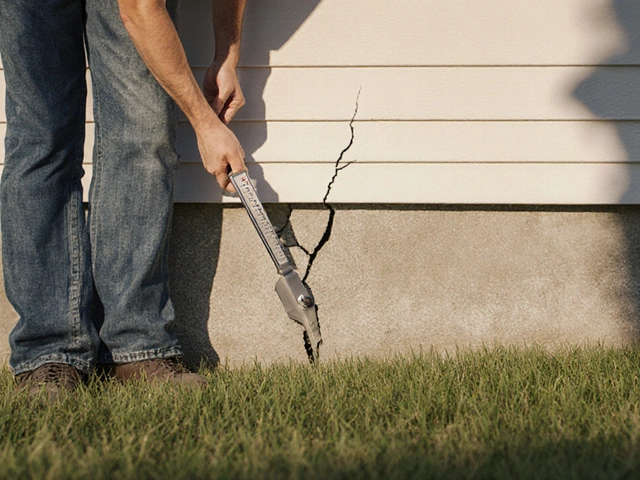So you've spotted a crack in your foundation and now you're wondering - should you fix it from the inside or go for an outside repair? This is a pretty common dilemma. Both methods have their pros and cons. It's not just about patching things up but making sure it stays that way.
When dealing with concrete cracks, it's crucial to pinpoint their cause first. Sometimes, it's just normal settling, but other times it might be something more serious, like water pressure or soil issues. Deciding whether to repair from inside or outside can depend a lot on what's really going on with your home.
If you're considering inside repair, it's typically easier and cheaper. You can fix things up without breaking the bank or your back, which is always a win! But, if water is sneaking in, sometimes it needs an outside approach to kick it out for good.
- Understanding Foundation Cracks
- The Case for Inside Repair
- The Benefits of Outside Repair
- Cost Considerations
- Water Intrusion Challenges
- Tips for Long-Lasting Repairs
Understanding Foundation Cracks
Noticing a crack in your foundation can be, well, cracking your nerves a bit, right? It doesn’t always mean doom, but it’s something you shouldn’t ignore. Foundation cracks come in all shapes and sizes, and figuring out what kind you’ve got is the key to deciding how to fix it.
There are mainly three types of cracks: shrinkage cracks, setting cracks, and structural cracks. Shrinkage cracks are usually the least of your worries. They often appear as tiny, hairline cracks and are just part of the concrete's natural curing process. Setting cracks may show up vertically, and while concerning, they’re usually just due to your house settling in its spot more solidly. Structural cracks? They’re the big guys that need attention. These cracks can indicate problems with the integrity of your home’s foundation and often run vertically or horizontally.
According to Fred Nussbaum, a civil engineer with decades of experience, "A small crack today can turn into a bigger problem tomorrow. It's essential to understand the nature and origin of the crack to address the real issue."
So, how do you actually determine what you’re looking at? Here are a few things to check for:
- Size of the crack: Small hairline cracks are less worrisome than wide, gaping ones.
- Direction: Vertical cracks might be less serious compared to horizontal ones, which could mean water pressure against the wall.
- Water presence: If you’ve got moisture seeping through, you might have a bigger issue on your hands beyond just the crack itself.
Keep a close watch on these, and when in doubt, don’t hesitate to consult a professional who knows their stuff. This is one of those times when guessing is not the best strategy.
The Case for Inside Repair
When you spot a crack in your foundation, the idea of fixing it from the inside might sound like a convenient option. Fixing foundation cracks from the inside usually means getting to work without digging up your yard or tearing apart your driveway. That right there is a major win for a lot of homeowners who don't want their landscaping disrupted.
Inside repair usually involves sealing up cracks using methods like epoxy or polyurethane injections. These materials expand to fill the crack and create a watertight seal. Think of it like giving your foundation a big, sturdy bandage from within that stops water in its tracks. It's especially effective for cracks that aren't too wide and aren't causing major water leaks.
One of the best things about opting for an inside repair is that it's often less expensive than outside repairs. You've got fewer materials and labor involved generally because you're working from within the basement or crawl space. Plus, you don't need to worry about non-stop rain showers delaying the work.
Quick repairs can be another reason to choose the inside method. Instead of waiting for the perfect dry spell to open your wallet outside, you or a contractor can tackle the issue right away. It's a quick fix that can often be done in a single day, depending on the extent of the damage.
Now, if cost is stressing you out, here's a little perspective: inside repairs usually cost between $300 to $700 a crack, depending on length and width. Not every crack is created equal, but this gives you a ballpark idea of what to expect. Comparatively, for larger, external work, costs can quickly exceed $1,000 since you're dealing with excavation and additional barriers.
Inside repairs are quite the attractive option for those looking to make quick fixes and avoid the hassles of external digging. However, for more problematic situations like water seeping into your basement every time it rains, you might need to consider other options. Inside repairs work well for less severe crack issues, helping delay the need for more extensive repairs down the line.
The Benefits of Outside Repair
Tackling foundation crack repair from the outside often sounds like a big job, but it can seriously pay off. One major perk is that it directly confronts the source of the problem, especially if you're dealing with water intrusion causing chaos. By digging around the foundation and sealing cracks from the outside, you're blocking water before it even gets a chance to sneak into your basement or crawl space.
Another plus for outside repair is its lasting effectiveness. External fixes tend to be more durable compared to quick patches from the inside. This means less worry about dealing with recurring issues down the line, which every homeowner appreciates. Plus, outside methods provide a chance to enhance drainage around your home, reducing future risks.
And let's not forget the protection for your home’s structure. Repairing from the outside helps maintain the integrity of the whole foundation, stopping moisture from causing wood rot, mold, or damage to interior finishes. While it might require more upfront work, it often means fewer headaches later on.
- You get to address drainage problems directly, which can prevent new cracks from forming.
- There's the chance to waterproof your basement completely, protecting it from water damage.
- The repairs improve your home’s market value by maintaining a strong foundation and a healthy living environment.
Check out this quick comparison of outside and inside repairs when it comes to stopping those annoying water leaks:
| Method | Effectiveness for Water Intrusion |
|---|---|
| Outside Repair | High |
| Inside Repair | Moderate |
All this makes tackling the foundation crack repair from the outside a solid choice for those looking to ensure long-term solutions, especially if your home plays host to frequent wet weather challenges.

Cost Considerations
Alright, let's talk about money because we all know repairs aren't cheap! Deciding whether to fix foundation cracks from the inside or outside is going to hit your wallet differently. Generally, tackling cracks from the inside repair is the less pricey route. Why? Mainly because it involves less labor and you don't have to tear up the whole yard to get things done.
With inside repairs, you might be shelling out somewhere between $500 to $1,500, depending on the extent and the products used. Typically, this involves injecting epoxy or polyurethane to seal the crack, which is effective for non-structural cracks. This is especially handy if you're on a tight budget and the problem isn't too severe.
On the flip side, outside repair generally costs more, often ranging from $5,000 to $10,000. But don't gasp just yet. This option can be more thorough, especially if water is a recurring villain in your basement saga. When you opt for outside fixes, this might involve excavation and installing waterproof barriers or weeping tiles, which can give longer-term peace of mind against leaks.
| Method | Cost Range |
|---|---|
| Inside Repair | $500 - $1,500 |
| Outside Repair | $5,000 - $10,000 |
Sure, the numbers might seem steep, but think of it as an investment in your home’s future. A slip-up now might mean more costly repairs later. Weighing these cost differences will help you plan better and get the best bang for your buck when fixing those pesky foundation cracks. So, before you choose, consider the scope of the problem and how much you're willing to spend for your peace of mind.
Water Intrusion Challenges
Dealing with water intrusion? It's like trying to keep rain out with a leaky umbrella. Once water sees a way in, it's relentless. It's a big reason why homeowners might favor an outside repair for their foundation crack repair. Stopping water at the source is often the best strategy.
When water sneaks into the foundation, it can cause setbacks. There's extra pressure on the concrete, which might lead to bigger cracks down the road. Why risk future headaches when you can tackle it correctly now?
Let's break down how outside repairs work for this dilemma. They usually involve digging around the foundation to add a new barrier or drainage system. It's like giving your house a raincoat. Important elements like membranes and weeping tiles play a huge role here.
If you're in a region where heavy rain and floods visit frequently, an outside repair might be the wise choice. Sure, it's more work, but it tackles the water problem directly, rather than just mopping up the symptoms on the inside.
These outside fixes can get a tad pricey and maybe even mess up your garden a bit, but think about the peace of mind you'll gain. It's like investing in a good pair of boots to avoid soaked socks. Long-lasting and often worth every penny!
On the flip side, inside repairs can still be an option if water problems are mild. It might involve filling cracks and adding sealants. Just know that while this helps, it's usually a temporary fix, especially in homes with persistent water issues.
Tips for Long-Lasting Repairs
When you're fixing foundation cracks, it's essential to think ahead. Nobody wants to revisit the problem in a few years. So, what's the game plan for keeping those repairs solid over the long haul?
First off, make sure you're using quality materials. Cheap stuff might seem like a good idea now, but it won’t stand the test of time. Go for the trusted brands in sealants and support materials. Remember, inside repair might demand a different set of materials compared to outside repair.
Here’s a checklist to make sure your repair lasts:
- Identify the root cause: Before sealing any crack, understand why it appeared. It might be water drainage issues or shifting soil.
- Proper surface prep: Clean the crack thoroughly. Remove any loose debris or dust before applying any sealant or patch.
- Use flexible sealants: These allow for natural material movement without cracking again.
- Ensure good drainage: Make sure your home has proper drainage. Gutter systems should divert water away from the foundation, which could undermine foundation crack repair.
- Regular inspections: Check your foundation once in a while. Spotting minor issues early on can prevent major repairs down the line.
If you're curious about how much effort folks put into this, check this out:
| Frequency of Inspection | Percentage of Homeowners |
|---|---|
| Monthly | 20% |
| Quarterly | 35% |
| Annually | 30% |
| Only after problems arise | 15% |
Keep in mind that expert advice is invaluable. They can offer insights that you might not consider. Sometimes, the guidance of professionals can turn a good repair into a great one. Don't hesitate to reach out if needed!



Write a comment